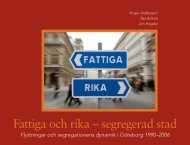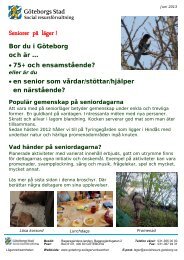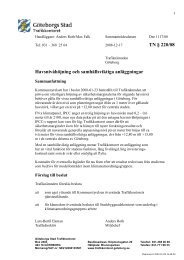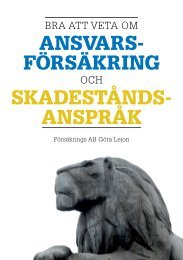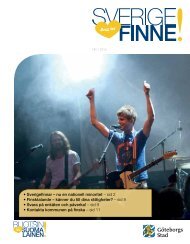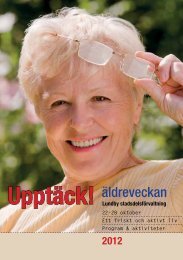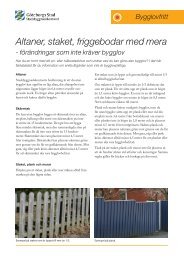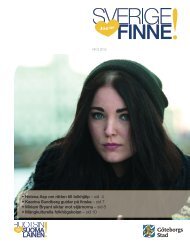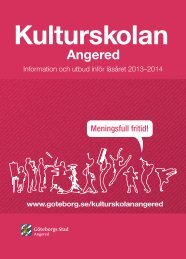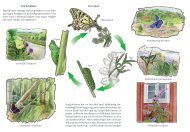Skiascope 1 som pdf - Göteborg
Skiascope 1 som pdf - Göteborg
Skiascope 1 som pdf - Göteborg
Create successful ePaper yourself
Turn your PDF publications into a flip-book with our unique Google optimized e-Paper software.
ständigheten”, enligt Berndt Lindholm. 5 Sistnämnda var en deposition<br />
i museet från Kungl. Vetenskaps- och Vitterhetssamhället. 6<br />
Tre år senare, 1864, inrättades Konstavdelningen i en sal med<br />
överljus i den västra flygelns norra del. Drivande bakom beslutet<br />
var S. A. Hedlund, <strong>som</strong> tidigare varit den avgörande kraften bakom<br />
inrättandet av <strong>Göteborg</strong>s konstförening 1854. I egenskap av museistyrelsens<br />
sekreterare var han, enligt uppgift från Carl Lagerberg,<br />
museets verkliga överhuvud. 7 Ansvarig för Konstavdelningen i egenskap<br />
av museistyrelsemedlem var från och med 1861 James J:son<br />
( Jameson) Dickson, 8 och intendent var stadsarkitekten Victor von<br />
Gegerfelt. Vid öppnandet upptogs en långvägg på översta våningen<br />
av Konstföreningens och museets samlingar, bland vilka två landskap<br />
av Edvard Bergh och Amalia Lindegrens porträtt av Adolph<br />
Tidemand särskilt märktes. På den motsatta väggen hängde de verk<br />
<strong>som</strong> ingick i årets utlottning på konstföreningen. Dessutom hade tre<br />
verk lånats av Bengt Erland Dahlgren: Tidemands Den sårade björnjägaren,<br />
Carl D’Unkers båda målningar En spelsal i Wiesbaden och Ett<br />
konstberidaresällskap. 9<br />
Vid årets slut uppgick museets samling till 30 verk, varav 25 målningar.<br />
Flertalet hade donerats. Följande år överlämnade <strong>Göteborg</strong>s<br />
konstförening sin samling om elva verk och fortsatte fram till 1878<br />
att skänka konstverk till museet. Sammanlagt kom föreningen att ge<br />
30 verk till museet. Ett museum <strong>som</strong> också upplät utställningslokaler<br />
till Konstföreningen, vars verksamhet kom att betraktas <strong>som</strong> en<br />
integrerad del av Konstavdelningens verksamhet. 10<br />
Expansionen fortsatte i ganska hög takt. 1869 hade samlingarna<br />
vuxit till 78 verk varav 63 målningar. Detta år utkom Octavia Carléns<br />
guidebok till <strong>Göteborg</strong>. Hon ägnar drygt 30 sidor åt att beskriva<br />
<strong>Göteborg</strong>s Museums samlingar och dess historia. Det är en noggrann<br />
och levande beskrivning av stort och smått – ända till Carlén<br />
når fram till Konstavdelningen. Denna behandlas på en knapp sida<br />
och består endast av en lista över ett tiotal verk samt namnen på<br />
ytterligare några representerade konstnärer. 11 För den <strong>som</strong> vill få en<br />
bild av konstens dåtida exponering finns tyvärr inget att hämta hos<br />
Carlén.<br />
Victor von Gegerfelt ersattes 1874 av Magnus Lagerberg <strong>som</strong><br />
samtidigt var intendent för Myntkabinettet ( vilket också var hans<br />
stora intresse). 1877-1878 sköttes Konstavdelningen av poeten och<br />
62<br />
63<br />
von Gegerfelt. At the inauguration, one of the longer walls on the upper<br />
floor was filled with the Society of Art’s and the museum’s own collections,<br />
of which Amalia Lindegren’s portrait of Adolph Tidemand and two<br />
landscapes by Edvard Bergh drew particular attention. On the opposite<br />
wall hung the works that had been selected for exhibition that year by<br />
the Society of Art. Three further works had been lent by Bengt Erland<br />
Dahlgren : Tidemand’s The Wounded Bear-hunter, and Carl D’Unker’s<br />
paintings A Gaming-Room in Wiesbaden and Circus Company. 9<br />
By the end of 1864 the museum’s collection comprised thirty works<br />
of art, of which twenty-five were paintings. Several had been donated.<br />
The following year the Gothenburg Society of Art donated its collection<br />
of eleven works, and until 1878 continued to donate works of art to the<br />
museum. Altogether it would give thirty works. The museum was also to<br />
lease exhibition premises to the Society of Art, and their activities came<br />
to be seen as integral to the department of art. 10<br />
The expansion continued with considerable speed. By 1869 the<br />
collection had grown to seventy-eight works, of which sixty-three were<br />
paintings. In that year, Octavia Carlén’s guidebook to Gothenburg was<br />
published in which she dedicated <strong>som</strong>e thirty pages to a description of<br />
the Gothenburg Museum’s collections and its history. It is a careful and<br />
lively description, with no detail too small to be left out – until Carlén<br />
reaches the department of art, that is. It is treated in less than a page, and<br />
amounts to a list of ten art works plus the names of a few other artists who<br />
were represented. 11 For anyone who wants a sense of the installation of art<br />
works at that time, there is little to be learned from Carlén.<br />
In 1874 Victor von Gegerfelt was replaced by Magnus Lagerberg,<br />
who at the same time was curator of the numismatic collection ( his great<br />
passion ). Then in 1877–8 the running of the department of art was taken<br />
on by the poet, and later critic, Carl David af Wirsén ( 1842–1912 ), who<br />
was also lectured and responsible for the library. He has gone down in history<br />
for his unusually conservative line as a critic and for his clashes with<br />
a list of Swedish notables, August Strindberg amongst them, but when it<br />
comes to his career as a museum official there is not much to go on. He<br />
had a Ph.D. in history of literature from Uppsala, and had worked for a<br />
time as a master at a grammar school. In 1871–2 he lived in Italy, ‘partly<br />
for the care of his health, partly for the pursuit of art-historical studies’. 12<br />
He came to Gothenburg with the help of Viktor Rydberg, with whom he<br />
was soon to fall out, however. 13



